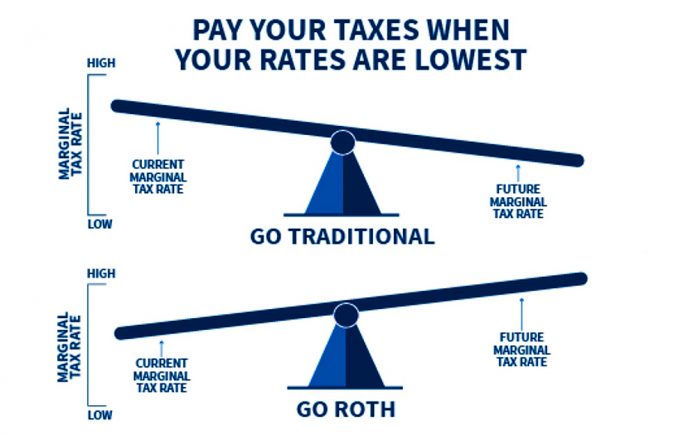
By Haddon Libby
Nearly four in five Americans have access to a 401k retirement plan at work, yet only four in ten of those employees participate. People who do not participate typically cite limited financial resources. To show how little one must save in order to have a more secure retirement, if you invested $3.33 a day for the next forty years through your 401k plan and earned an 8% return, you would have $350,000. Simply eliminating one coffee a day or eating out one less time a week results in a pretty big pile of money.
When saving for retirement, you have the choice of contributing before tax or after tax.
Your gut instinct tells you to make the contribution before tax thus reducing your taxable income. Why give the government your hard-earned money any sooner than you absolutely must? As with many things in life, the decision that is in your best interest may not be the obvious one.
With a Roth retirement account, you contribute money after-tax. By paying taxes today, any monies that you earn on these investments are tax-free when you take the money out in retirement.
To decide whether to contribute to your retirement account via the traditional pre-tax 401k plan (or 403b, 457b or SEP IRA) or use an after-tax Roth IRA, think about your life in retirement. Do you expect to be paying more in taxes once you retire? If you think your tax rate will be higher, you will want to maximize your contributions to a Roth IRA before using the more common pre-tax 401k.
A basic rule of thumb is to consider using a Roth IRA when your effective tax rate is under 15%.
As an example, if your effective tax rate is 10% this year and 25% once you retire and begin using these funds, you will have 16.7% more money to spend in retirement by using a Roth. Meanwhile, if you pay a high tax rate like 35% today and expect to earn less and have a lower tax rate like 15% in retirement, you will have 30% more to spend in retirement by going with a 401k plan.
To figure out your effective tax rate, get your latest tax returns. Look at the first two pages of both the federal and state tax returns. As an example, the 2018 1040 form shows your total taxes paid on line 15. Write that number down. Next, write down your adjusted gross income number in line 7. Divide line 7 by line 15 to get your effective Federal tax rate.
Next, do the same thing for your state tax return. Using California as the example, on form 540, total taxes paid can be found on line 64 while your taxable income figure is on line 19. By dividing line 19 by 64, you get your effective State tax rate; by adding your Federal and State tax rates together to get a rough idea as to your effective tax rate. Once you have that number, determine whether you expect to pay more or less than that in retirement.
Still unsure? Talk to someone. If you are part of an employer’s 401k plan, there is usually a professional available to guide you on such things. A good advisor will help you in understanding your financial condition and building a plan that will help you in reaching your objectives.
If the advisors’ efforts center on selling you additional products over offering advice, get a second opinion from a fiduciary advisory firm like ours. Fiduciary advisors unlike broker advisors must disclose every penny that they make along with any potential conflicts of interest. For unbiased advice, fiduciaries are expected to provide a best-in-class standard of care to clients whereas broker advisors do not have to provide that same standard of care.
Haddon Libby is the Founder and Managing Partner of Winslow Drake Investment Management. For more information on their services, please visit www.WinslowDrake.com or email Hlibby@WinslowDrake.com.








































